The 2023-24 UEFA Women’s Champions League group stage has now come to an end, with several groups coming down to the wire.
New faces such as Brann, Häcken, Ajax, and Benfica are making the quarter-final stages for some exciting clashes to come.
However, this data analysis will look at some of the data and statistics that will provide a nice summary of the top performers from this season’s group stages. We will break this down into four key areas: defending, ball progression, creativity and goal scoring, in order to cover a wide range of players across the board.
Defending
In this section, we will outline some of the standout performers on the defensive end of the ball this season.

In this first graph, we have outlined the total interceptions against the proportion of the team’s interceptions. The purpose of this graph is to not only shine a light on those players who are leading the competition in interceptions, such as those indicated by the pink dots, but also to identify some players who are performing above their teammates but potentially in a side that is more dominant such as Barcelona or Lyon who aren’t required to defend for as long and as a result should have lower defensive numbers on average, these players have been indicated by a yellow circle as opposed to a dot.
Now, to pick out some key performers in terms of players dominating the rest in interceptions per 90, you have Benfica defender Christy Ucheibe, who leads the way with an average of 9.75 interceptions per 90, followed closely by Paris FC defender Célina Ould Hocine on 9.27.
Then let’s draw some attention to the two Barcelona fullbacks in Ona Battle and Lucy Bronze, who, although they are only making 5.34 and 5.18 interceptions per 90, respectively, are a significant proportion of Barcelona’s total interceptions. This is largely because Barcelona have averaged 67.39% possession in the Champions League so far this season. As such, the still relatively high number of interceptions is even more impressive for these two players than face value would suggest.
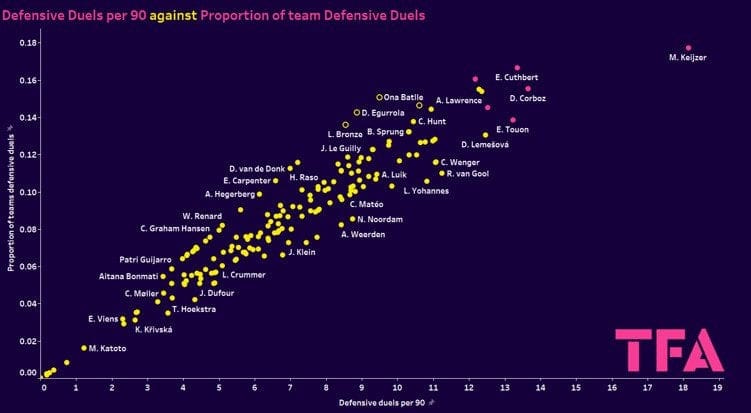
The aims of this graph are similar to those of the previous graph as well. Trying to identify any players who stand out above the expected rate. What we have is the runaway leader in Ajax’s 20-year-old right back Milicia Keijzer with a remarkable 18.14 defensive duels, which she is completing at a success rate of 61.04%; this leads the next best by 4.48 from Paris FC midfielder Daphne Corboz on 13.66.
Then, let’s look at some alternate key performers again. You have the two Barcelona fullbacks, Battle and Bronze, who have a significant impact on the defensive end of the ball for Barcelona. However, we have some other names to look at here, such as Roma full-back Lucia Di Guglielmo, who completed 10.61 defensive duels at a rate of 65.52%, a significant part of Roma’s defensive play. In addition to these three players, Lyon’s central midfielder Damaris Egurrola impressed in this area with 8.86 defensive duels per 90 at a very impressive success rate of 77.42%.
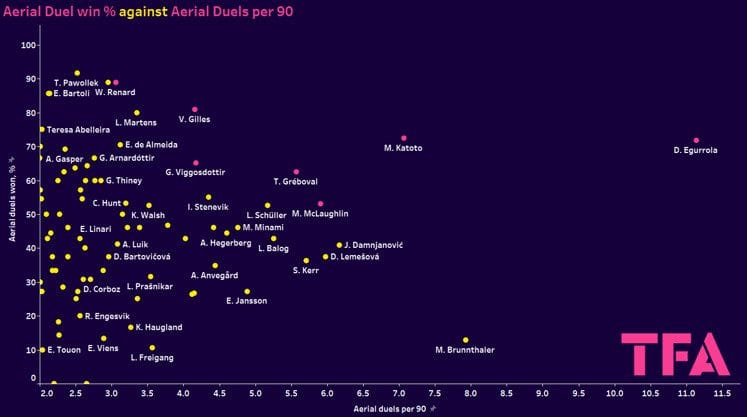
Although not a strictly defensive metric, we have decided to include aerial duels in this section to highlight some key players on a different side of the game. With aerial contests being more associated with a direct style of play in addition, you would expect both central defenders and centre forwards to be the leaders in this metric; however, it is Egurrola, a midfielder, who leads the way with 11.14 aerial duels per 90 at a success rate of 77.42%. In addition to this, you have players such as PSG centre forward Marie-Antoinette Katoto and Paris FC’s central defender Théa Gréboval impressing in this area of the game.
Then you also have players such as St. Pölten-Spratzern’s Melanie Brunnthaler and Diana Lemešová, who, despite competing in 7.93 and 5.98 aerial duels per 90, respectively, were only completing these at a success rate of 12.9% and 37.5%. This might help to demonstrate some reasons as to why they struggled in this season’s Champions League campaign.
Ball Progression
In this section, we look to shine a light on the leading ball progressors from this season’s Champions League group stage.
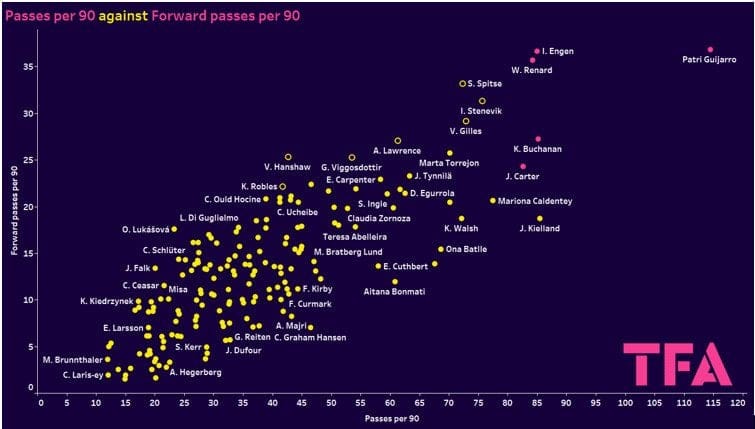
The purpose of this graph is to shine a light on those players who are a vital part of their respective sides in possession; we have compared this with the number of forward passes, as forward passes would imply that they are able to progress the ball and, therefore, team forwards in possession.
As we might expect, the top of the leaderboard is dominated by Barcelona, Lyon and Chelsea, with the clear standout being Patricia Guijarro, who has been playing a staggering 114.47 passes per 90, 32.2% of which have been played forwards.
However, some other impressive performers you might not expect to see up near the top are Brann’s central defender Ingrid Stenevik, averaging 75.65 passes per 90 41.4% of which have been played forwards. Another player to highlight is Frankfurt’s left-back Verena Hanshaw, who has been averaging 42.68 passes, with an impressive 59.2% of those passes being played forwards.
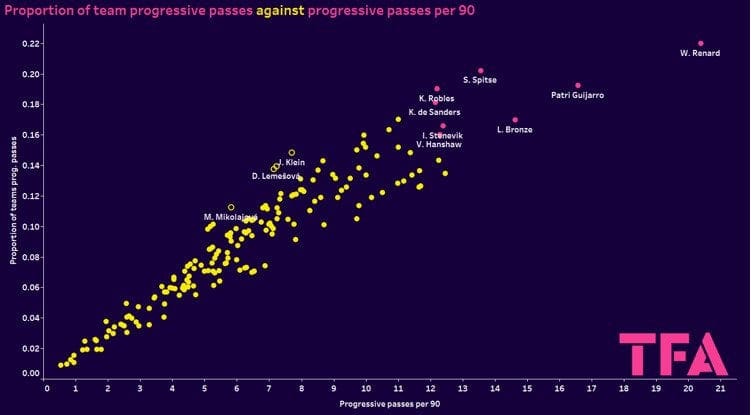
Now, we are going to look directly at progressive passes against the proportion of their team’s total progressive passes. Again, the top of the leaderboard is dominated by Lyon and Barcelona players. Lyon’s central defender and captain Wendie Renard led the way with 20.38 progressive passes per 90, leading the next-best Guijarro by 3.8 progressive passes per 90.
In addition to these players, you can see Stenevik and Hanshaw high up the list again. You can also see the two Ajax central defenders, Sherida Spitse and Kay-Lee de Sanders, with a significant 13.56 and 12.15 progressive passes per 90, which played a significant part in earning Ajax their first-ever Women’s Champions League quarter-final berth in club history.
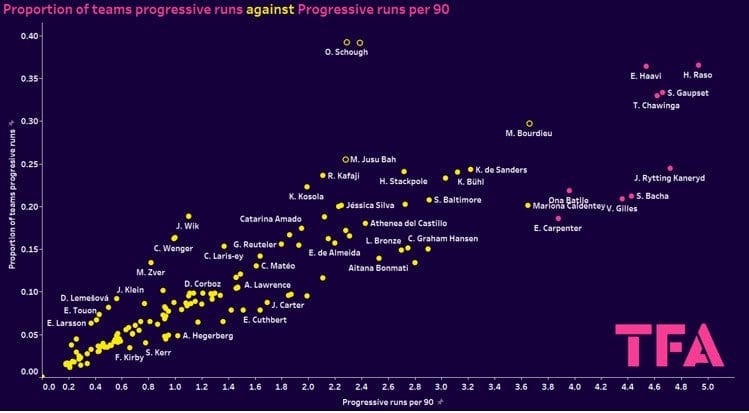
This graph here highlights a different but still very important aspect of ball progression: the ability to carry the ball up the field with the ball at their feet. The leader in this category was Real Madrid’s Australian winger Hayley Raso, who averaged 4.93 progressive runs per 90. In addition to Raso, you have a lot of familiar names in Lyon’s Selma Bacha, PSG’s Tabitha Chawinga and Chelsea’s Johanna Rytting Kaneryd. However, some less familiar names to highlight are Brann’s 18-year-old winger Signe Gaupset, who averaged 4.66 progressive runs per 90, which puts her in the top three players from the group stages. Roma’s Norwegian winger Emilie Haavi also averaged 4.54 progressive runs per 90.
So those are some of the leaders in the category; however, two other players stand out: Sarah Mattner-Trembleau from St. Pölten-Spratzern and Olivia Schough from Rosengard. Although these players only completed 2.39 and 2.29 progressive runs per 90. They contributed to the most significant proportion of progressive runs. Significantly outperforming their two struggling sides in the group stage.
Creativity
This section will outline some of the leaders in some vital creative metrics from this season’s Champions League group stage.
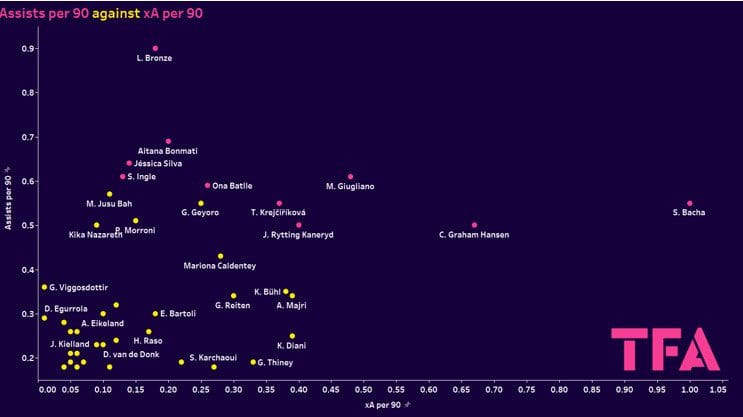
The graph above is designed to outline the quality of production compared to the conversion of those chances created. So, in terms of the most quality chances being created, the two leaders are Lyon’s left-sided Selma Bacha, who has an xA per 90 of 1, which leads the way, followed by Barcelona Caroline Graham Hansen on 0.67 xA per 90, still a remarkable number. However, despite these two creating a significant number of chances for their respective teams, this hasn’t necessarily translated directly to more goals converted.
Whereas somebody like Barcelona’s Lucy Bronze or Aitana Bonmati have significantly lower xA per 90 at 0.18 and 0.2, respectively; however, they lead the way in assists per 90 with 0.9 and 0.69 respectively. Now, this could suggest one of two things: either the chances are falling to more clinical players who are converting lesser chances into goals for them. Alternatively, it could mean that they might not be creating as many chances as the likes of Bacha or Hansen, but their chances are of higher quality. You would imagine that is a bit of both, with Barcelona having high-quality players at their disposal.
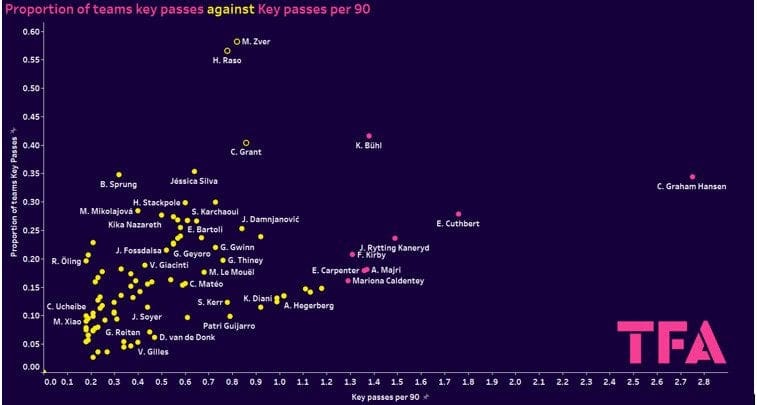
In this graph, we are trying to shine a light on some players who are outperforming their team and might get lost by dominant sides on the European stage. Barcelona Hansen leads the way with a remarkable 2.75 key passes per 90, which leads the competition by 0.99 to the next best, Erin Cuthbert from Chelsea. Again, you will notice some other familiar names who lead the way, such as Barcelona’s Mariona Caldenty, Chelsea’s Fran Kirby, Lyon’s Ellie Carpenter and Amel Majiri.
However, in addition to these familiar names, some players who were key parts of their side’s creative play in this season’s Champions League group stage are Madrid’s Raso, Bayern’s Klara Bühl and 35-year-old winger Mateja Zver for St. Pölten-Spratzern. These players averaged 0.78, 1.38 and 0.82, respectively; however, these three players all attributed to over 40% of their side’s key passes, which just goes to show how important they were to their sides.
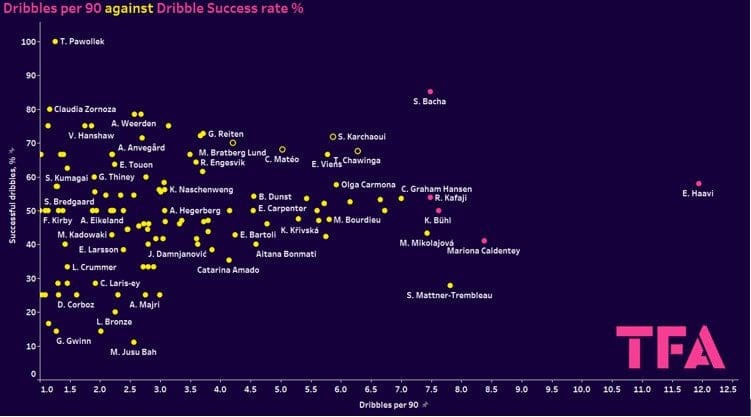
Although not necessarily a creative metric however, the logic behind including this here is that dribble success rate can, in theory, create the space you need to create chances for your team. A couple of names that instantly stand out are Roma’s Haavi, who averaged 11.94 dribbles per 90 at a success rate of 58%, which leads the way. However, the most efficient dribbler was Lyon’s Bacha, who 7.48 dribbles per 90 at a staggering rate of 85.19%. Some other highly efficient dribblers include PSG’s Sakina Karchaoui and Tabitha Chawinga, completing 5.87 and 6.28 dribbles per 90 at a success rate of 71.88% and 67.65%, respectively.
Some other names to highlight are Häcken’s young attacker Rusul Kafaji, who averaged 7.48 dribbles per 90, which put her into the top 5 players of the group stage, completing these at a success rate of 53.85%. Additionally, Roma’s Canadian forward Évelyne Viens averaged 5.78 dribbles per 90 at a success rate of 66.67%, completing two out of every three dribbles.
Goalscoring
We will outline some of the top goal converters from this season’s group stage.
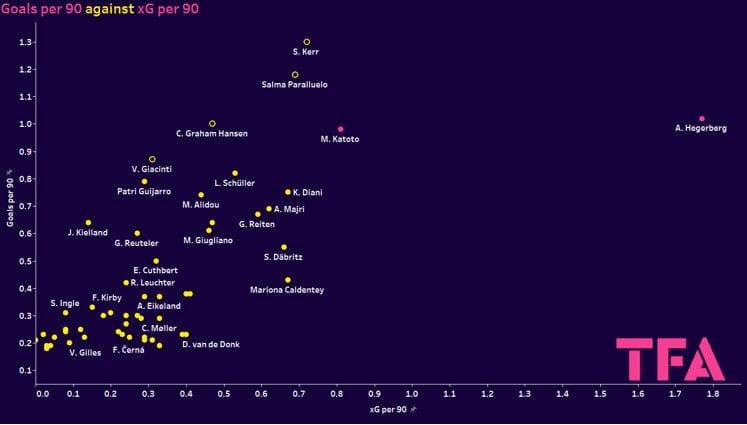
The first graph here compares the number of goals scored per 90 to the average xG per 90. The logic behind this is to identify the most efficient players in front of goal. So, for example, Ada Hegerberg leads the way in xG per 90 with a ridiculous 1.77 xG per game; however, she is converting at a goal per 90 rate of 1.02, so she is underperforming on xG by 0.75.
Some familiar faces again turn up at the top of the standings, with Chelsea’s Sam Kerr converting her xG per 90 of 0.72 by 0.58 and scoring an average of 1.3 goals per 90. Kerr is closely followed by Barcelona’s Salma Paralluelo, who has averaged an xG of 0.69 and converted 1.18 goals per 90. It is no wonder that these two lead the overall goal top goal scorer standings with five goals apiece.
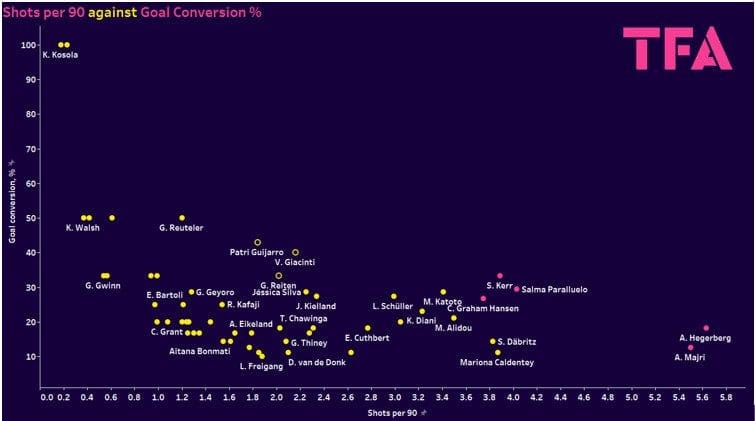
This graph here is designed to identify any players who are converting at a rate higher than we might expect. We might suggest that Lyon’s Hegerberg and Majiri have been wasteful in front of goal, with their high number of shots being converted at less than 20%.
Again, we see Paralluelo, Kerr and Hansen being strong performers in terms of goal conversion, with them converting at 29.8%, 33.3% and 26.7%, respectively. Some less familiar names that you might have come across are Benfica’s Canadian centre forward Marie-Yasmine Alidou, who has converted her 3.5 shots per game at a rate of 21.1%, attributing to Benfica’s success in getting out of the group stage. In addition to Alidou, Roma’s centre forward Valentina Giacinti, although only averaging 2.4 shots per game, had a conversion rate of 40%, converting just under one out of every two shots, which is a remarkable rate.
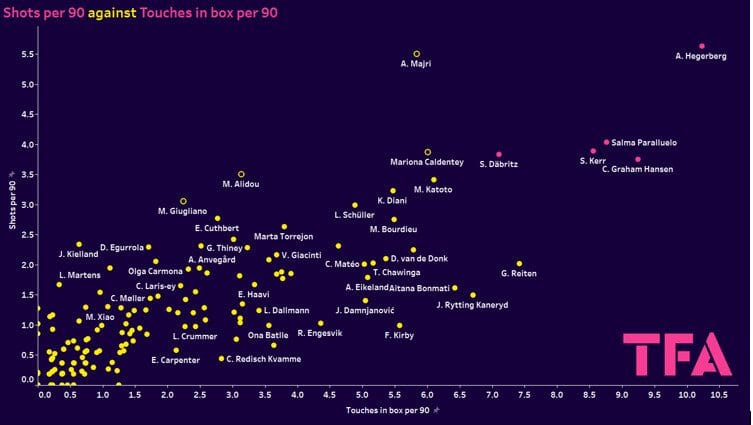
This graph is designed to highlight the link between touches in the box and goals per 90. This could help suggest how efficient these players, in fact, are inside the box.
Leading the way is Hegerberg again, with 10.23 touches in the box per 90. This is closely followed by the usual suspects Hansen, Paralluelo and Kerr. Another who impresses in this area is Lyon’s Sara Däbritz, who averages 7.11 touches in the box and 3.83 shots per game with a touches-to-shots ratio of 1.86, so just under every two touches in the box is a shot.
Another player with an impressive touches-to-shot ratio is Benfica’s Alidou with a ratio of 0.90 this would potentially suggest that she has several shots from outside of the box, which would contribute to a lower xG. A similar story could be said for Roma’s Giugliano and Häcken’s Kafaji, who have touches-to-shot ratios of 0.73 and 0.62, respectively.
Conclusion
This data analysis has provided some context for the key players from this season’s Champions League group stage, in addition to highlighting those players who will continue to have a significant impact in the latter stages of the tournament.
It’s also important to shine a light on some of those other players who may have exited the competition early at the group stage yet still performed at a high level in what was a hotly contested group stage, with a number of the groups coming down to the wire, some even the last ten minutes of the game.






Comments